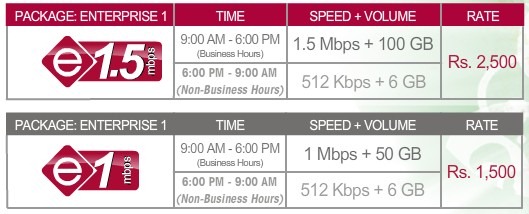wi-tribe Introduces Enterprise Packages: ProPakistani |  |
- wi-tribe Introduces Enterprise Packages
- Celcos’ Minified Attention Towards Postpaid Brands
- PTA Issues ‘Telecommunication System Clock Synchronization Regulations’
- Mobile Broadband Verses Fixed Line Broadband
| wi-tribe Introduces Enterprise Packages Posted: 05 Apr 2011 11:56 PM PDT wi-tribe Introduces Enterprise Packages is a post from: ProPakistani wi-tribe has introduced enterprise packages with higher data limits during business hours (9 AM to 6 PM). These enterprise packages are aimed at business and high end users with rich data upload/download need. You can choose between two packages of 1.5 Mbps and 1 Mpbs speed with 100 GB and 50 GB data limits respectively. Introduction of enterprise packages from wi-tribe shows that the company realizes the high bandwidth needs of the consumer/businesses. wi-tribe already offers endless package (30 GB Limit) for the consumers. Tariff:
How to get wi-tribe connection: Visit your nearest wi-tribe outlet or call 111-187-423 Related posts:
|
| Celcos’ Minified Attention Towards Postpaid Brands Posted: 05 Apr 2011 10:15 PM PDT Celcos’ Minified Attention Towards Postpaid Brands is a post from: ProPakistani
What has been surprising overall, is the fact that almost all the service providers have been aggressively advertising promotions for prepaid subscriber base, while very few companies, if any, have paid any attention to the huge corporate sector as well as the postpaid market. The bottom line for any operator (worldwide) is highly dependent on its postpaid subscriber base, since they are the customers with the highest usage (ARPU), and as such, are responsible for the companies earning most of their profits. Even now, the most synonymous brand associated with postpaid connections is Indigo, whereas all other brands have faltered. ZONG has a very limited postpaid subscriber base and as such, no postpaid brand whereas Persona (Telenor) & Zahi (Warid) have been virtual non starters. The Zahi brand is being replace by Postpaid (a generic term) while Ufone simply calls its postpaid brand as: Postpay. Let's start off with the countdown of the brands: Beginning with one of the most familiar postpaid brand, Indigo, The flagship brand of Mobilink. It has the largest postpaid subscriber base and the largest portfolio of corporate accounts. The longevity of this brand is a result of long term planning, with advertisements and promotions targeting postpaid subscribers as well as Corporate customers. One of the only brands offering reward points (like credit cards), discount on handsets, promotions on new handsets as well as numerous other features. They have everyone trying to play catch-up and are far ahead in the brand race. Next on the countdown we have, surprise surprise, Zahi from Warid Telecom. One of the most underrated brands, it seems even the users themselves are not aware that it is called Zahi. With minimal advertising and almost no focus on the brand, they were able to increase their large subscriber base through their tie-ups with sister companies like Bank Al-Falah as well as a strong selling strategy highlighting their competitive tariff and better network quality. Further on ahead on this countdown comes Postpay by Ufone. Ufone started off pretty well, in fact by challenging Mobilink's supremacy in the beginning; they were even able make forays at Mobilink's corporate portfolio. But with the launch of other operators such as Telenor and Warid, Ufone diverted all its attention towards getting as large as pie of the prepaid market as possible. Suffice to say, Ufone was not the only one playing this game. With little or almost no attention being given to the postpaid brand, it reflects the general state of affairs for postpaid subscribers in the industry. Telenor, one of our European giants made a great start with prepaid brands such as the now famous Djuice and Talkshawk; everyone had high expectations from Persona but they faltered just like everyone else. The beginning was really good, but they failed to keep the momentum and now their prepaid brands overshadow their postpaid one. I would like to talk about ZONG as well, but their postpaid brand is simply non-existent which reflects upon their postpaid as well as corporate subscriber base. But the interesting thing about ZONG is that they are trying really hard. Hopefully, we will see some more focus on the postpaid brands by the service providers since they can only neglect this sector on their peril. Related posts:
|
| PTA Issues ‘Telecommunication System Clock Synchronization Regulations’ Posted: 05 Apr 2011 10:14 PM PDT PTA Issues ‘Telecommunication System Clock Synchronization Regulations’ is a post from: ProPakistani Pakistan Telecommunication Authority (PTA) has issued regulations for all telecom operators to synchronize the clock, time, date of telecommunication systems for error free data recovery, accurate reconciliation of Call Data Record and Internet Protocol Records. The regulation has been named as "Telecommunication System Clock, Time, and Date Synchronization Regulations 2010," which has been made public recently. These regulations shall apply to all Long Distance Interconnects (LDI), Landline (LL)/Cellular mobile/CVAL Data licensee for the purpose of synchronization of their system clock to ensure fair reconciliation of call detail record (CDR) and IP detail record (IPDR) data in line with the criterion/ratings determined by the PTA from time to time. All licensees shall be obliged to align their frequency of their telecommunication system in accordance with the Primary Reference Clock (PRC)* and Synchronization Supply Unit (SSU)** for provision of error free data of intelligence transmitted over various network nodes, the regulation stated. All licensees with high speed backhaul networks shall have at least two alternative sources of PRCs. The telecom operators shall be obliged to maintain frequency of their telecommunication systems containing NTP (Network Time Protocol) secondary server at least NPTv4 complaint wherever applicable. They shall be obliged to upgrade their telecommunication systems as and when are required by authority, it stated. The operators are asked to provide complete information of their telecommunication clock system to the authority which includes clock, date and time synchronization architecture and degree of accuracy. On the basis of PTA findings and/or at least 10 complaints filed to the PTA against a licensee in one month, the authority shall initiate an investigation process through a nominated officer. The PTA will conduct manual test/inspections that may be replaced with an automated process subject to the availability of advanced tools. It may place the relevant data for public information. PTA's designated division shall present the test results to its board within a period of 30 days from completion of the Date and Time verification survey process. The operator will provide access to the authorized representative of the authority for obtaining information, inspection and audit of the telecommunication systems network in order to ensure the compliance of parameters as provided in these regulations. *Primary Reference Clock (PRC): It means an autonomous clock, operating independently of other sources that provide the reference synchronization signal to all other clocks within a network as referred in ITU-T G.811 Recommendation. **Synchronizations Supply Unit (SSU): It means the logical system for frequency referencing, its processing and distribution as prescribed in ITU-T G.811 Recommendation. For detail view, click the below link: http://www.pta.gov.pk/media/clock_sync_reg_280311.pdf Related posts:
This posting includes an audio/video/photo media file: Download Now |
| Mobile Broadband Verses Fixed Line Broadband Posted: 05 Apr 2011 10:10 PM PDT Mobile Broadband Verses Fixed Line Broadband is a post from: ProPakistani
Knowing the fact that Government of Pakistan is trying hard to introduce 3G in the country, we thought it would be a good idea to compare 3G Mobile Broadband with hardwired high speed Internet service or what you call it DSL. So, with the assumption that you have a choice between some sort of a hardwired Internet service, DSL or cable, and mobile broadband, either 3G or 4G (after it is introduced), and also that you don’t want to take on the expense of having both, lets' make a brief comparison of the two types of Internet connections and examine their pros and cons. DSL offers these advantages:
The disadvantages of DSL and cable fixed line broadband are:
3G and 4G Internet connections offer some benefits:
Disadvantages of 3G and 4G The disadvantages of mobile broadband connections are currently considerable, but technology of this type can change so rapidly that there is every reason to expect that these will soon be gone.
Ultimately, the decision between fixed line and mobile broadband internet connections is up to the individual. However, the key factor will remain the price for 3G or 4G. There is currently no one-size-fits-all solution, and what suits your requirements today could change tomorrow, and changes in technology will constantly offer new options and change the game again. Related posts:
|
| You are subscribed to email updates from Pro Pakistani To stop receiving these emails, you may unsubscribe now. | Email delivery powered by Google |
| Google Inc., 20 West Kinzie, Chicago IL USA 60610 | |


 9:45 PM
9:45 PM



 Having seen the industry moving from one operator to two and then to as much as five operators (not counting SCO) with the subscriber count, as per PTA, to
Having seen the industry moving from one operator to two and then to as much as five operators (not counting SCO) with the subscriber count, as per PTA, to 